How to Live Stream Conferences and Virtual Meetings [2025 Update]
When the COVID-19 pandemic hit about five years ago, conference organizers across the globe were forced to postpone their events, sometimes indefinitely. As a way of adapting to the changing times and to keep up the efficiency, they started live streaming conferences and virtual meetings.
Now that the pandemic has passed, the era left behind a new way of working and interacting that thrives on live streaming software for seamless communication. This is because of the convenience and flexibility it provides.
With live streaming software, event organizers are not restricted by geographical limitations, logistical challenges, or travel expenses. Instead, they can plan and execute their conferences on time — and often for less cost — with the potential to reach an even larger audience.
Let’s take a look at what live streaming and VOD software can do for virtual conferences, as well as some key features to look for in the technology used to execute live streaming conferences.
Please note that conference live streaming features and virtual event technology are always changing. We have updated this post to reflect the most up to date trends as well as the top conference streaming platforms as of 2025.
Table of Contents
- What is live Streaming?
- What is VOD?
- Live Streaming vs. VOD
- Benefits of Streaming Virtual Events
- Why You Should Live Stream Your Conferences
- Features to Look for in a Conference Streaming Platform
- Top Conference Streaming Platforms for 2025
- FAQs
- Conclusion
What is Live Streaming?

Live streaming is the internet equivalent of watching live television; a conference or event is sent over the internet and watched by people across the globe as it is happening.
One solution to turn those missed opportunities into extra revenue is to stream the live events to others. This creates added value for presenters and capitalizes on people unable to attend.
Streaming a live event online not only allows people who would have attended in-person events to participate from afar, but it also opens up the opportunity for people who wouldn’t otherwise be able to participate in an in-person event to attend. This broadens your conference’s audience, increasing your reach and boosting profits.
In addition, you can also stream a Zoom meeting and make it available as Video on Demand after the event, as well.
What is VOD?
Video on Demand, or VOD, allows viewers to access pre-recorded video and play it back at their leisure. This is possible because video content is compressed into digital files and stored on a centralized server for easy access. With VOD, viewers have the flexibility to choose what they want to watch from a wide range of online video libraries.
If you stream virtual conferences that are recorded and published for VOD access, for example, your conference attendance can easily be magnified by allowing access to people who couldn’t physically attend in-person events or whose schedules didn’t allow for attendance on the live stream.
Live Streaming vs. VOD
Caption: Give users access to your content by live streaming and recording for later use on demand.
Many users view live streaming and VOD as very different entities serving different purposes. However, they’re more akin to two sides of the same coin; two different methods for getting your content out to the audience who will most benefit from seeing it.
Both methods involve streaming content over the internet, but one is streamed as it’s created, while the other is recorded and can be streamed for later viewing.
Content that has been broadcast live can, with the right equipment and streaming platform, be streamed VOD.
Some platforms, especially the free live streaming platforms such as Facebook Live, only allow for live streamed content. While using a free platform has its advantages for some businesses, those that wish to be able to capture their virtual conference content for use on-demand need a platform that allows for both live streaming and VOD capture.
Benefits of Streaming Virtual Events

Here at Dacast, we’ve witnessed first-hand the impact of using a live streaming platform to maximize the reach of a wide variety of professional virtual events. Some of the applications and benefits of live streaming conferences and virtual streaming events include the ability to:
- Stream key parts of sold-out venues to extra viewers
- Provide a more comprehensive and value-rich service to companies and presenters
- Offer access to past virtual events and presentations for on-demand viewing to supplement live broadcasting
- Increase event relevance and reach through broadening and globalizing audience
- Broadcast pre-show material to help heighten attendee engagement and community interest
- Create sample videos to generate interest, boost attendance lead to premium content spending; and
- Highlight sponsors’ products in videos or interview exhibitors’ executives.
Now let’s take a look at some of the factors you’ll want to consider before deciding how to best live stream your event.
Why You Should Live Stream Your Conferences
Live streaming your conferences and meetings may take a thorough event planning process, some extra equipment, and know-how, but it comes with a variety of advantages for your business. Here are our top reasons to live stream a business conference.
Get People Excited

Part of getting good attendance at your virtual conference is to get people excited to be part of the event.
By creating a live stream of your event, you give yourself a built-in promotional opportunity. You can advertise the live stream of your conference to your mailing list and social media followers, regardless of where they are located, allowing more people to attend.
Showcase Your Tech Knowledge
Live streaming conferences and meetings takes a certain measure of technological knowledge.
Knowing how to operate the equipment to capture the stream, the virtual conference software to stream the content and the ability to promote the virtual conference digitally are all crucial skills that set your conference apart from others.
Leveraging the technology that’s necessary for live streaming conferences and meetings demonstrates that you and your team possess the capability to adapt to changing technology, showing your ability to evolve as your industry changes.

When you host in-person events, your profits are limited to what you can make on the tickets you charge for people who are physically present. And, that profit is only calculated after you subtract all the other costs of hosting, including facility and equipment rental, food for attendees, and travel costs for your presenters.
But with the right virtual conference monetization strategies, viewers can attend from all over the world, broadening your reach. Having lower overhead costs also helps you attract and host more paying attendees, as you can keep ticket prices lower.
Feature More Big Names
Making the time to present at a virtual conference is a big ask for many people, especially people who are more prominent in your field or who are famous in their own right.
If you’re able to live stream a conference or meeting, allowing speakers to participate across the globe, you may be able to attract more high-profile, even expensive, speakers than you otherwise could. This can, in turn, improve your conference’s visibility and attendance, and boost profits.
Features to Look for in a Conference Streaming Platform

There are many streaming solutions for adding an online connection for your meetings, online events, or conferences. As you explore your options, your checklist should include areas such as compatibility and performance. The ability to target both desktops and mobile devices is key in today’s market.
The performance and overall reliability of your streaming service and internet connection are also crucial. These factors apply to any live venue. Trade shows, which can see dramatic increases in viewership via live streaming, especially want to consider these technical aspects.
In order to capably stream virtual trade shows, online events or conferences, you need a platform that helps you record your footage, promote it, distribute it and, if you choose, record it for later use.
To get the most out of your live streaming conference content, there are six important features to look for in your chosen platform:
- Video Encoding and Transcoding
- Live Stream Recording
- Video Security and Privacy
- HTML5 Video Player
- Live Streaming CDNs
- Unlimited Concurrent Viewers
- Live Event Video Monetization
- Video CMS
Using these tools and features allows you to present a professional live broadcast video to your viewers, making all the time, money, and effort you spent preparing for your virtual conference worthwhile.
1. Video Encoding & Transcoding
You can host the best conference live stream ever, but if your virtual attendees can’t view your content, all your work will be fruitless.
When your content is streamed online, it’s crucial to utilize encoding software that can show the images from your camera in a format playable by viewers at home. This process, called transcoding, is done automatically by a professional live conference streaming solution. Transcoding takes the RAW files directly from your camera and turns them into something that can be viewed in a browser or mobile app.
And when you record that live broadcast content for VOD playback later, you need to be able to provide your viewers with video in the format that plays best for the browser they’re using and their internet speed.
To do this, automatic video encoding takes the files you upload and presents them to each viewer individually. This helps viewers receive a smooth, enjoyable playback experience without having to worry about adjusting their settings manually.
Here are some of the best encoding software you can use for video encoding and transcoding.
- Dacast (built-in live encoding and transcoding)
- vMix
- VLC
- OBS Studio
- AVS Video Converter
- HandBrake
- Wirecast
2. Live Stream Recording

Presenting a conference via live stream takes a great deal of work and time investment. Multiply your impact by recording your live streaming content for later release on demand.
The right platform allows you to simultaneously record and live stream your online events, allowing you to release the video to a wider audience and maximize your profits. Without a tool that integrates live streaming and recording, you have to set up multiple programs in order to live stream and record, complicating the whole operation.
3. Video Security & Privacy
You spent a lot of time and money putting together a great conference, and you want to ensure that you’re only giving access to the people who have paid to attend.
Advanced security and privacy features allow you to protect your content from thieves and restrict access to those who don’t deserve it. Tools such as domain control, encrypted streaming, password protection and watermarking allow you to protect your property from unauthorized eyes.
4. HTML5 Video Player
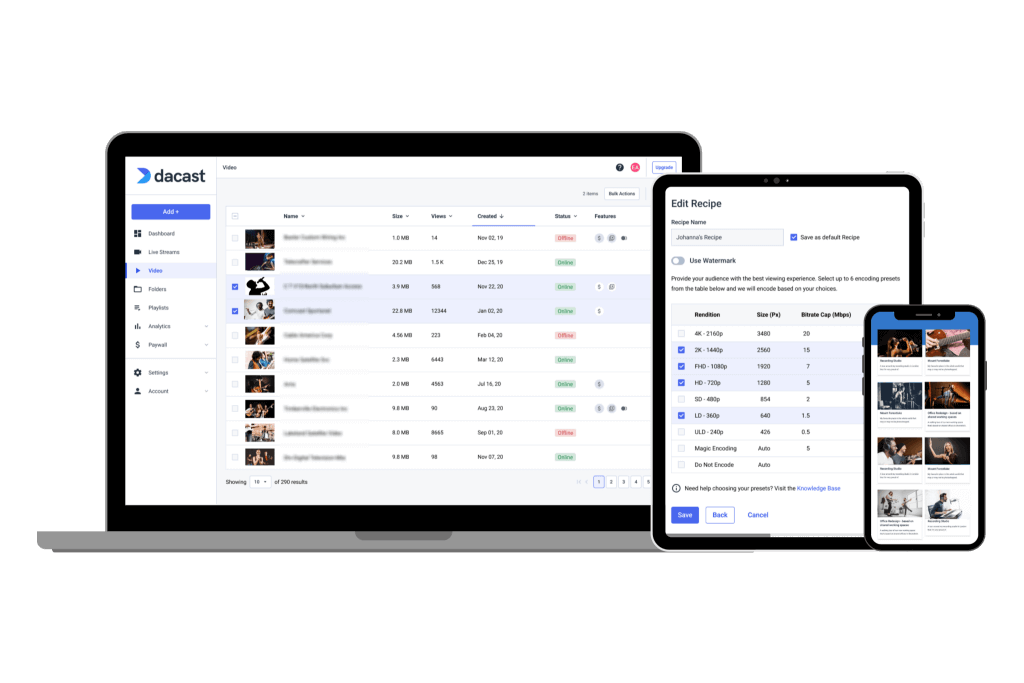
More and more, people are watching video content — including entire live streaming conferences and meetings — on mobile devices.
And because mobile technology changes so rapidly, it can be difficult for individual developers to keep up with all the new specs and requirements to play content seamlessly. By using an HTML5 video player, however, your content can play on any device or browser automatically without requiring your users to download new technology in order to participate in your conference.
The right live conference streaming platform already has HTML5 video player capability built right in, so you don’t even have to give it a second thought on whether or not your content can be played by all viewers.
5. Live Streaming CDNs
Beyond considering compatibility, you also want to take reliability into account. First, you want to look for a service that offers a video CDN (Content Delivery Network) connection. A CDN is a fast, often worldwide network of servers. A CDN exists to deliver content via the internet. This includes all types of content: text, images, video, and more.
CDNs enable global delivery of content, which is a big advantage. They are most often used to distribute large files, for example, video content. You should expect a good-quality CDN to access a server in close proximity to your viewers. This helps to avoid large delays from servers that could otherwise be far away from the viewer, thus disrupting their streaming experience.
Using a live streaming CDN also allows broadcasters to reach broader audiences. Without a server network, you run the risk of congestion. Congestion occurs when too many people try to watch content at the same time via the same server. This is a common issue when broadcasting from a small network of servers, and especially if you are using a single server to broadcast. For this reason, you want to be able to guarantee your viewers a powerful and global CDN.
6. Unlimited Concurrent Viewers
A conference platform that is used for broadcasting virtual events should have the ability to support unlimited viewership for its live streams. The Dacast platform has no viewer limit for videos on any pricing plans or accounts. We have facilitated broadcasts with hundreds of thousands of concurrent viewers.
Dacast uses a global Content Delivery Network (CDN) that allows users to stream to vast audiences without the concern of hitting a “limit” that would overwork a smaller server network. The platform also supports full 1080p HD broadcasting, mobile device support, secure video delivery, content scheduling, player customization, and more.
7. Live Event Video Monetization
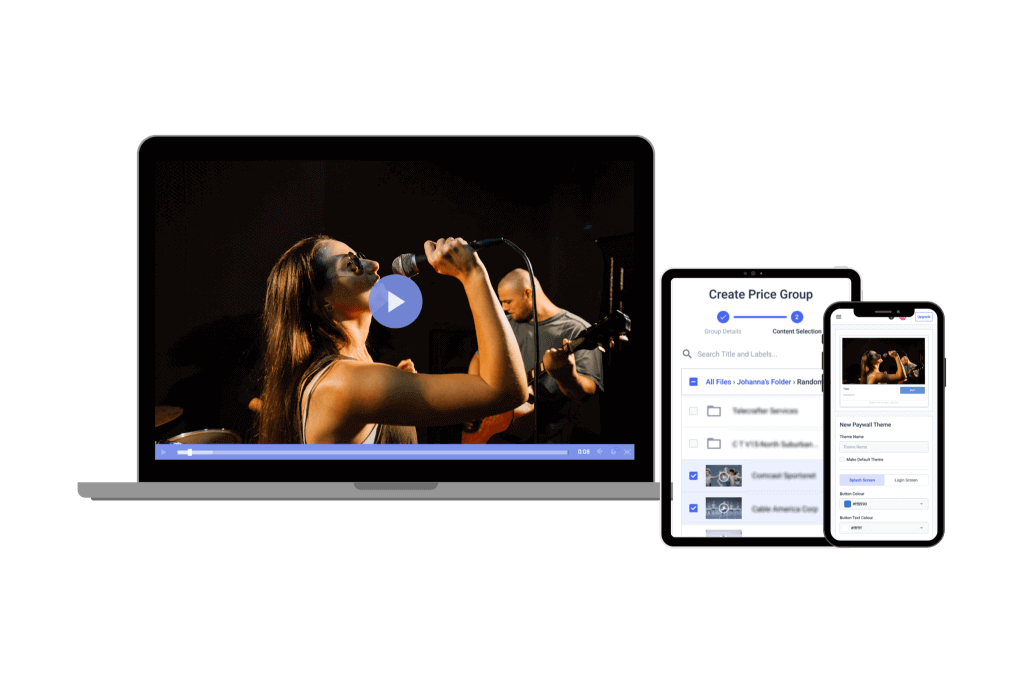
Being able to monetize your live conferences is essential to the health of your business. And it’s important that you be able to monetize your content in a way that works best for you and your viewers rather than trying to make a platform’s chosen monetization method work for you.
With many live stream platforms, especially free ones, you are pigeon-holed into either not being able to make money directly off your live streams (such as with Facebook Live) or only making money in the way the platform allows (such as with Twitch).
A professional live streaming platform, on the other hand, provides options for content monetization so you can select what works best for your business model. This feature particularly comes in handy for event planners.
Do you want your users to pay monthly or annually for access to your content? Subscription-based monetization (SVOD) will work for you.
If your virtual conference revenue will work best by selling individual ticketed access, then Transactional Video on Demand (TVOD), or pay-per-view streaming is the model you want to utilize.
And if your conference will be supported by revenue from advertisements you play during the live stream, then a platform that allows for Advertising Video on Demand (AVOD) is a necessity.
Whatever monetization method you choose, it’s important that you have options to suit your needs so your virtual conference proves a success and helps you reach your goals.
8. Video CMS
Part of being able to easily share your video content with new viewers is being able to easily store and find your content.
While it may be easy to live stream the conference you’re working on right this moment, you likely have a whole wealth of prior recordings that you can use to draw revenue and gain new viewers. A platform that allows you to easily upload, transcode, organize, monetize, analyze and share your past video content means you can make money off that new live streaming conference and meeting online as well as last year’s instructional video.
The right video CMS not only makes it easier for you to find and share your content, but it also makes it easier for your viewers to find the content that may interest them.
If, for example, a viewer attends your conference live stream, your video CMS can suggest related videos from your library for them to view later. This boosts attendee engagement — and potentially giving you their business — for longer.
Top Conference Streaming Platforms for 2025
Now that we have outlined the top features to look for in platforms you can use for live streaming conferences and meetings, we wanted to compare 5 of the top services to stream virtual events. We’ll go into the key features, pros, and cons, as well as the live streaming costs associated with virtual events in 2025.
Let’s get started!
1. Dacast
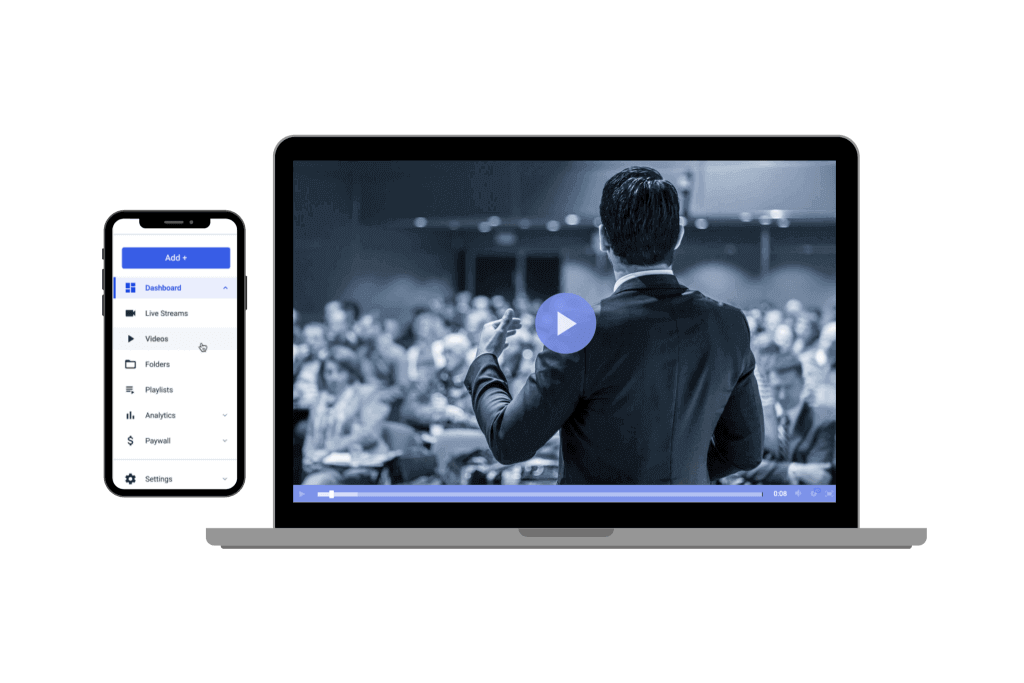
Platform Overview:
With offices in Beijing, London, Manila, and San Francisco, Dacast is considered a competitive offering in a crowded marketplace. Dacast is a full-featured, self-service solution for live streaming and VOD hosting.
Dacast is a unified streaming solution that makes the annual list of the most important, innovative, and interesting live stream companies on the 2021 Streaming Media Magazine’s Top 50 List. This powerful video hosting platform helps companies worldwide scale and monetize their online video content.
Basic Functionality:
Dacast provides comprehensive live streaming and secure video hosting services. Users can embed videos on their websites while maintaining 100% control of their content. Among other features, Dacast offers an integrated paywall, password protection, referrer restriction, and an analytics dashboard.
Key Features:
- Monetization tools (SVOD, AVOD), and pay-per-view (TVOD)
- White label and branding control
- Adaptive bitrate streaming to allow multiple streams with varying bitrates
- RTMP Encoder for ingesting HLS streaming
- Low latency HTML5 channels for video streaming
- Live encoding support for the top video encoders
- Zoom live streaming integration
- Expo galleries video portal
- Unlimited viewers and live channels
- Video security tools for secure streaming
- Global content delivery with strategic CDN partnerships
- Multi-bitrate streaming
- Player API and Video API access
- 24/7 tech support
New!
- M3U8 file creation capability to enable adaptive streaming delivery of OTT video content across various devices
- Multistreaming capabilities for simulcasting to multiple platforms at once
- Fully integrated RTMP streaming platform features
- AES encryption for secure video streaming
- Multi-user access on Scale and Custom plans
- Zoom live streaming integration for meetings and live events in real-time
- Expo 2.0 galleries video portal for immersive video experiences
Pros:
- VOD and live stream video hosting
- Real-time analytics
- Ad-free streaming
- Wide range of privacy and security tools
- Mobile device support
- Live stream recording
- China Video Hosting
- Plans for every budget
Cons:
- A large range of features require a bit of an initial learning curve
Pricing:
Dacast has multiple live streaming pricing plans. Here is a quick summary of all plans:
- Starter: $39/month billed annually (includes 2.4 TB bandwidth and 500 GB storage)
- Event: $63/month billed annually (includes 6 TB bandwidth and 250 GB storage)
- Scale: $165/month billed annually (includes 24 TB bandwidth and 2 TB storage)
- Custom: if your enterprise business has high-volume streaming needs, you can contact Dacast for a custom plan tailored to your needs.
2. IBM Cloud Video
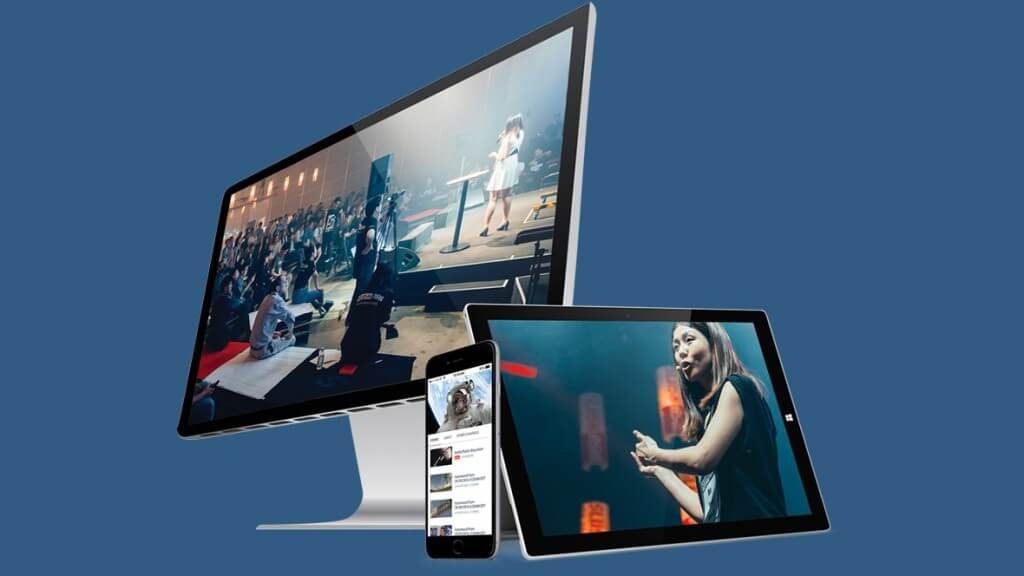
Platform Overview:
Next up in our online video platform comparison is IBM Video Streaming (formally UStream). Founded in 2007 to connect military service members with family, IBM purchased UStream in 2016.
Around the same time, IBM acquired ClearLeap, a video management system, Cleversafe, a video storage service, and Aspera, a large-file transfer tool. All of these different companies were used to create IBM Cloud Video (now IBM Video Streaming), allowing IBM to become a platform for live streaming and VOD.
Basic Functionality:
IBM Video Streaming is a live streaming company first and foremost. However, it also hosts VOD (Video On Demand) files recorded from previous live streams.
Basic streaming accounts are free, with advertising supporting IBM Video Streaming. Paid accounts remove advertising and grant access to advanced features. Enterprise accounts allow for full custom branding and offer analytics, multiple live channels, content syndication, and more. The more you pay, the more custom live stream services you have access to on IBM Video Streaming.
Key Features:
- Powerful video analytics
- Tools for boosting user engagement (including polling)
- Auto-archiving
- Powerful content delivery
- Tools for video monetization
Pros:
- Tools suited for business use
- Customer support
- Hong Kong video hosting
Cons:
- Extra fees for streaming at high resolution
- Limited tools for accessibility (minimal closed captioning support)
Pricing:
IBM pricing plans include the following:
- Start Trial – Video Streaming: Give it a free test drive for 30 days
- Silver: Affordable Essentials, 100 viewer hours, 5 channels, 1 TB video storage, starting at $145/month
- Gold: Standard business features, 2,000 viewer hours, 10 channels, 2 TB video storage, starting at $729/month
- Platinum: Premium Volume scale, 5,000 viewer hours, 20 channels, 5 TB video storage, starting at $1,460/month
- Custom: Please contact IBM Cloud video for custom plan pricing as well as payment plans
IBM Video Streaming also offers an SaaS streaming service with AI-driven deep search for security-rich video communications. Here are the IBM Enterprise Video Streaming pricing plans:
- Enterprise Silver: $847/month
- Enterprise Gold: $2,120/month
- Enterprise Platinum: $5,300/month
- Custom: Contact the sales team
30-day free trials are available for test-driving both the IBM Video Streaming and the IBM Enterprise Video Streaming services.
3. Kaltura
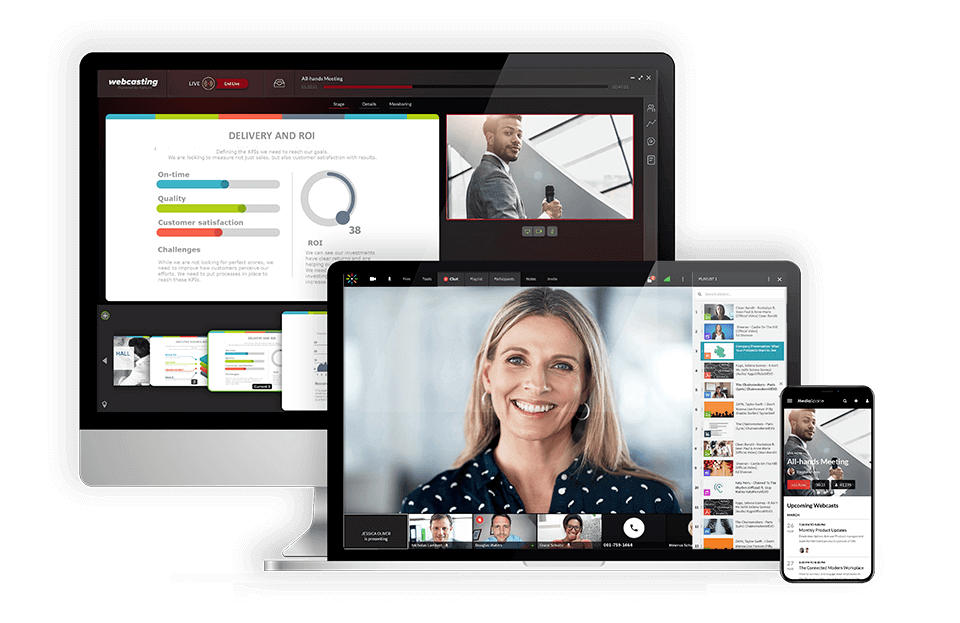
Platform Overview:
With a video management foundation in its open-source software, Kaltura offers a unique focus on the live streaming market. Historically, this company has worked most extensively with educational institutions.
Basic Functionality:
While the Kaltura software is free, it requires an infrastructure of servers for hosting and distribution. This platform represents an alternative to the self-hosted model (e.g., Dacast). That said, Kaltura offers cloud-based video hosting and distribution services for both VOD and live streams.
Key Features:
- Multi-bitrate and adaptive video streaming
- Monetization options (SVOD, AVOD, and TVOD) via integrations
- Powerful security features
- Total video and player API access
Pros:
- Completely customizable
- Very few limits on features thanks to integrations
- Well-suited for advanced broadcasters
Cons:
- The “pay-as-you-go” structure often makes it more expensive to use
- Complicated platform
- Not cut out for beginner broadcasters
- Slow-to-respond tech support
Pricing:
Prices are based on the solutions you’re looking for. These billed monthly plans include:
- Limited trial: $1 for two webinars
- Business: $199/month (or $150/month when billed annually)
- Enterprise: Custom pricing
- Free trial: 14 days; up to 25 participants per session
- Basic: $19/month (or $17/month when billed annually); up to 8 participants per session and 8 hrs of cloud recording
- Pro: $55/month (or $50/month when billed annually); up to 25 participants per session and 15 hrs of cloud recording
- Business: $125/month (or $115/month when billed annually); up to 100 participants per session and up to 25 hrs of cloud recording
- Business Plus: Custom pricing for up to 300 participants per session, unlimited sessions and custom storage needs
- Annual discounts: Discounted pricing packages available for any scale and use-case, enterprise SLA, and developer support
- Limited trial account: $1 for $100 worth of credits for 30 days for testing and experimentation, with no commitments
- Pay as you go – You pay only for what you use at these credit levels:
- Base plan: $20 one-time annual fee + monthly usage fees
Other services include virtual events, video portal town halls, video messaging, meetings, and more.
4. Wowza
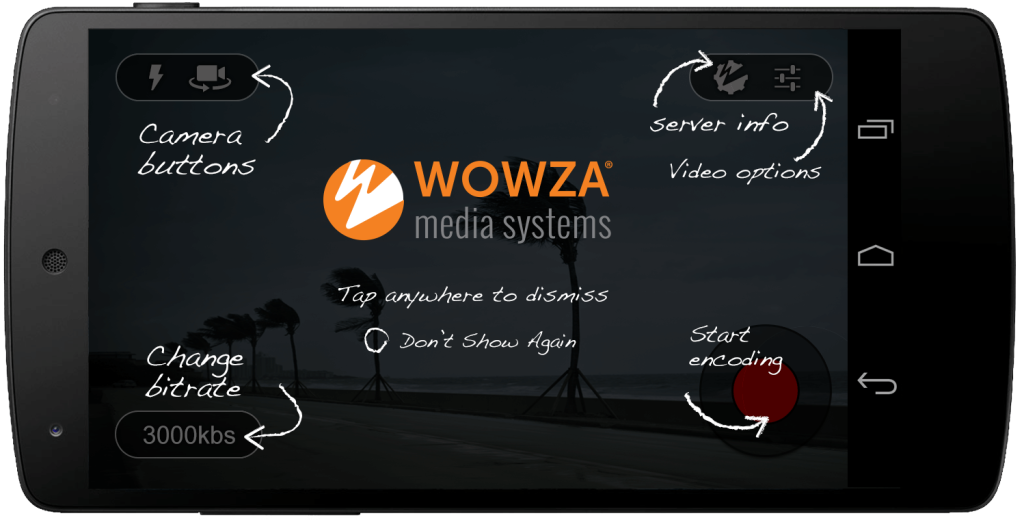
Platform Overview:
Founded in 2005 by David Stubenvoll and Charlie Good, Wowza is a bootstrapped start-up, with live and on-demand live streaming capabilities to phones, tablets, consoles, focusing on greater accessibility, further flexibility, and the best cost-effectiveness.
Basic Functionality:
Wowza offers two main products, the first of which is the Wowza Streaming Engine. This product is widely used in the industry for self-hosted streaming. Wowza streaming services, however, come with the Wowza offering. The Streaming Cloud functionality includes a variety of features aimed at providing low-latency content access to global audiences of all sizes.
Key Features:
- Cloud transcoding
- Support for live streaming and VOD
- White-label video player
- All-device streaming with an HTML5 video player
- API access available
- Reliable customer support
Pros:
- Brand customization tools
- Auto-archiving
- Powerful video CMS
- Ultra HD streaming (4K)
- Wide range of security options
Cons:
- No simulcasting tools
- No support for video monetization
- No reliable video analytics tools
Pricing:
Wowza offers two main tiers: Streaming Cloud and Streaming Engine.
The Wowza Streaming Cloud offers four distinct pricing plans and services. Live Event Pricing, monthly plans include:
- Pay As You Go: $0 per month only pay for usage at a rate of $2.50 per streaming hour and $0.10 per viewer hour
- One Month of Streaming: $149 one-time purchase; includes 15 hours of live streaming and 500 viewing hours
- Plans built for your needs: Best for large audiences and large volume videos, but you should contact Wowza for custom pricing
All the Live Event plans reflect rates when paid monthly and include full brand control, multi-bitrate streaming, and UHD and HD streaming.
The Wowza Streaming Engine has its own professional-grade streaming plans billed annually and includes:
- Basic Monthly: $195/month with the first instance included (Additional instances $195)
- One Month Streaming: $295/month with the first instance included (Additional instances $295)
- Enterprise: Please contact Wowza directly for access to their custom-tailored high volume enterprise solutions
5. Vimeo Livestream
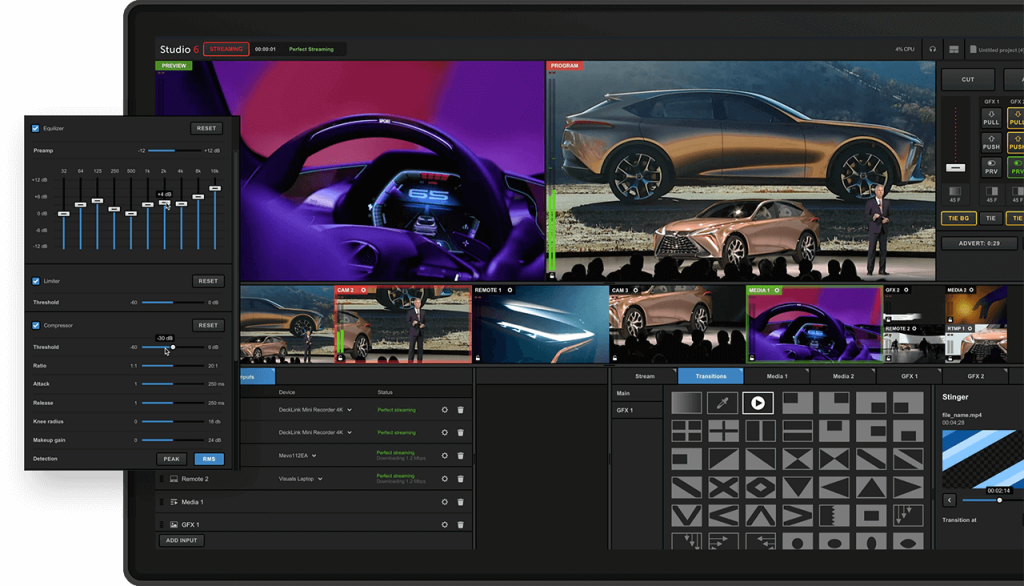
Platform Overview:
Since its founding in 2004, Vimeo has grown to be one of the most well-known video platforms on the internet.
Originally, Vimeo made its mark by offering an ad-free experience for video sharing, which made it an instant hit with creators and audiences. Now, it offers live streaming and enterprise video hosting space, with a range of services targeting businesses of all sizes.
The platform emphasises quality over quantity, which is appealing to many professional creators and businesses. Vimeo offers a cleaner user experience and a vast array of customization options.
Basic Functionality:
Vimeo offers live streaming, video hosting and OTT video delivery services. Vimeo is a cloud-based video streaming platform with comprehensive video hosting and livestreaming functionality. Vimeo has a simplified live streaming interface with features like text and graphic overlays and social share options. It also has plenty of tools that help with greater audience interaction.
Key Features:
- Cloud-based video hosting
- Small-scale streaming solution
- Text and graphic overlay
- Collaboration and interaction tools
- Social share options
- Flexible storage options
Pros:
Vimeo is simple to use, even if you are not a techie. They offer low-budget options so that small organizations can use the platform as easily as larger organizations. At the same time, the interface is very professional.
- User-friendly interface with simple navigation
- Great in-class security and privacy settings
- Good video playback quality
- You can embed your live stream video using this cloud streaming platform on your website.
Cons:
- Some issues with connection to an internal server
- No China video delivery
- Limited live streaming and video hosting capabilities
- Requires you to be tech-savvy to take full advantage of its features and have everything running smoothly
- The live event management system is pricier than other services and lacks robust features you’ll find on other platforms
- Buffering times are longer than other cloud video services
- You can’t convert the text in English to other languages.
Pricing:
Vimeo offers basic video hosting plans that are suitable for content creators and startups.
Pricing if billed monthly, is as follows:
- Free: $0/month; 1 GB storage, creation and editing, screen recording
- Starter: $20/month; 100 GB storage, auto closed captioning, custom URLs and video player, privacy tools
- Standard: $41/month; 1 TB storage, engagement and social analytics, AI script generator, teleprompter, brand kit
- Advanced: $108/month; 5 TB storage, stream to multiple destinations, host live broadcasts and webinars, AI-generated chapters and text summaries
- Enterprise: Custom pricing; more storage and bandwidth, advanced AI capabilities, quality events, dedicated support
Vimeo is great if you want to maximize the usage of your content by turning your live streams into VOD content.
Vimeo’s OTT solution is priced separately from the regular Vimeo packages. There are two plans: Starter and Enterprise.
- Starter Pricing: $1/subscriber per month
- Enterprise Pricing: Please contact Vimeo for custom pricing information
FAQs
1. How Do You Live Stream a Conference?
Here’s a step-by-step process explaininghow to live stream a conference.
- Identify your goals, intentions, and target audience
- Plan the details of your live stream, including the platform, e, agenda, and intended participants
- Select an online video platform
- Setup your broadcasting equipment
- Connect video and audio encoders
- Setup your source input
- Create a live channel
- Embed your live stream
- Do a test run
- Promote your live stream
- Start streaming
- Replay the live stream
- Carry out a post event follow up to find areas for improvement
2. Is Video Conferencing the Same as Live Streaming
Live streaming typically involves broadcasting content to a large audience, while video conferencing happens among a smaller group of people. Live streaming usually focuses on one-way communication or a primary speaker addressing a group of people, with little room for interaction. For example, live concerts.
On the other hand, the latter places emphasis on collaboration among members of a small group. For example, employee meetings.
3. How Much Does it Cost to Live Stream an Event?
The cost of a live stream depends on the type of equipment, camera setup, and streaming platform you use. Using Dacast’s video live streaming platform costs between $39 and $165 per month.
A single-camera live stream setup can cost roughly between $700 and $2500, while multiple camera setups can cost up to $6000 or more.
4. What is a VOD in Streaming?
Short for video on demand, VOD services allow users to access movies, tv shows, documentaries, and other video content whenever they want.
With traditional broadcast television, users can only access specific content at scheduled times and they often have no control over what they watch. However, VOD platforms give users the flexibility to watch video content at their convenience, as long as they have internet connection.
5. What is the Best Live Streaming Website?
Some of the best live streaming platforms include:
- Dacast
- Brightcove
- IBM Cloud Video
- JW Player
- Vimeo Livestream
Conclusion
In this article, we took a look at some of the potential benefits of incorporating live streams into your events. We also touched on some of the key factors to consider when deciding on a live streaming platform that’s right for live streaming conferences and meetings.
As the world has had to adjust to new ways of living, conference organizers have been forced to find new ways to host their events in a world that’s quickly shifted online. Thanks to the internet and modern live streaming platforms, conference hosts haven’t had to completely put their plans on hold until the world reopens; they’ve simply had to come up with a new way of doing things.
With professional-grade features, ease of use, and top-notch customer service, Dacast is the clear choice for anyone looking to start — or elevate — their live content streaming strategy.
Ready to try the platform named Best Small/Medium Business Platform by the 2019 Streaming Media Readers’ Choice Awards? Try Dacast free for 14 days. There are no long-term contracts to sign, no hefty start-up fees to pay and you won’t have to give us your credit card number to get started.
For exclusive offers and regular live streaming tips, you’re welcome to join our LinkedIn group. Have further questions, thoughts, or feedback about this article? We’d love to hear from you in the comments below. Thanks for reading, and good luck with your events.
 Stream
Stream Connect
Connect Manage
Manage Measure
Measure Events
Events Business
Business Organizations
Organizations Entertainment and Media
Entertainment and Media API
API Tools
Tools Learning Center
Learning Center Support
Support Support Articles
Support Articles